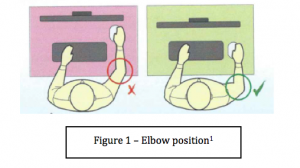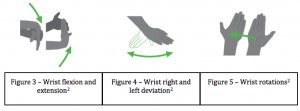Avoiding the mouse trap!
7 TIPS TO HELP AVOID MOUSE RELATED PAINS
Workers may spend up to 9 hours a day using their computer mouse. Unfortunately prolonged, repetitive or awkward working postures can lead to muscular and/or joint dysfunction. Some of the most common complaints associated with regular mouse use include wrist, shoulder and neck pain.
These common aches and pains may be eased by adjusting your workstation ergonomics and performing some basic exercises at your desk.
Below are 7 quick tips that may help avoid or relieve your mouse related pains:
1. Shoulder and elbow position
Set your chair height so that when your shoulders are in a relaxed position, your elbows should be 0-5cm above desk height. If your feet are unable to touch the ground, then a footrest may be required. Next, ensure you are not over-reaching for your mouse by keeping it adjacent to your keyboard and elbow by your side (figure 1). This allows your shoulder girdle and neck muscles to relax sufficiently to prevent injury. If your chair has armrests, please remove them if they push your elbows too high or prevent you from getting too close to the desk.

2. Wrist position
The wrist should be kept in a neutral position at all times. Avoid any flexion or extension of the wrist, and any deviation to the left or right (figure 2). Your keyboard and mouse should be set 10-25cm from the front of the desk so that you have some forearm support.
3. Head position Your head should be approximately arms length distance away from the monitor with the top 1/3 of the screen at eye level. This can be achieved by using a monitor arm or stand. Your head, keyboard and screen should all be centrally aligned.
4. Vary your mouse hand
A handy tip is to swap your mouse to your non-preferred hand. This can be tricky at first, but within 2 weeks you will be able to vary your mouse hand throughout the day. This will put less stress on your wrists and shoulders by easing the load.
5. Regular breaks
Taking regular breaks during the day will help reduce your risk of injury. If your job involves repetitive computer work, it advised to take 1-2 minute standing breaks every 30 minutes, and 5 second breaks from mouse use every 5 minutes.
6. Desk exercises
There are many simple exercises you can perform at your desk throughout the day. It is a good idea to implement these exercises during your regular breaks. A couple of these exercises are pictured below, however please see your physical therapists to discuss these further.
7. Ergonomic equipment
There is a range of ergonomic equipment available to purchase that can assist in avoiding or relieving your mouse related pains. However the equipment should be tailored to the individual and therefore it is crucial to discuss these products with your physical therapist. Below are a few resources available and how they may benefit your workstation.
• Vertical Mouse (figure 9) – A vertical mouse avoids forearm twisting and can help to alleviate and prevent wrist and forearm injury.
• Short/Mini keyboard (figure 10) – The short keyboard has a narrower profile (no number pad), which allows your mouse to be placed in alignment with your shoulder – relieving neck and shoulder discomfort.
• Wrist rest (figure 11) – The idea of the wrist rest is to keep the wrist as flat as possible and avoid any wrist extension (upward angle). However if you are using a wrist rest, please be sure you do not pivot your wrist on the padding.
References:
1. Corporate Work Health Australia. (2014). Ergonomic Workstation Setup.
2. Posturite. (2017). Workstation Exercises. Retrieved from http://www.posturite.co.uk/posture-learning-resources/workstation-exercises
3. ergonomics now. (2017). Ergonomic Products. Retrieved from https://www.ergonomicsnow.com.au/
Dr. Shaun Coghlan
The Osteopaths of Blackburn




